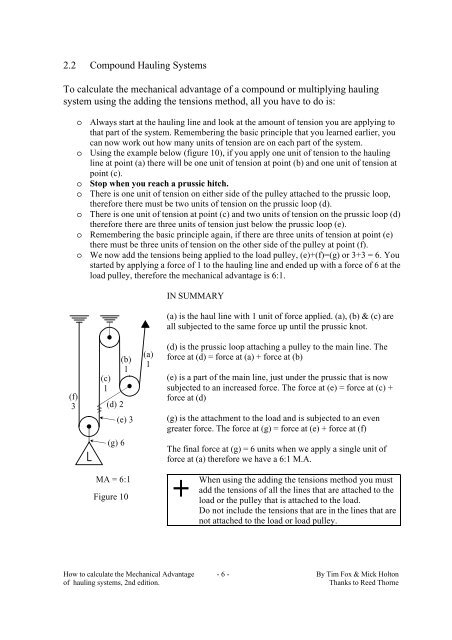Mechanical Advantage Paper.pdf
Mechanical Advantage Paper.pdf
Mechanical Advantage Paper.pdf
Create successful ePaper yourself
Turn your PDF publications into a flip-book with our unique Google optimized e-Paper software.
2.2 Compound Hauling Systems<br />
To calculate the mechanical advantage of a compound or multiplying hauling<br />
system using the adding the tensions method, all you have to do is:<br />
o Always start at the hauling line and look at the amount of tension you are applying to<br />
that part of the system. Remembering the basic principle that you learned earlier, you<br />
can now work out how many units of tension are on each part of the system.<br />
o Using the example below (figure 10), if you apply one unit of tension to the hauling<br />
line at point (a) there will be one unit of tension at point (b) and one unit of tension at<br />
point (c).<br />
o Stop when you reach a prussic hitch.<br />
o There is one unit of tension on either side of the pulley attached to the prussic loop,<br />
therefore there must be two units of tension on the prussic loop (d).<br />
o There is one unit of tension at point (c) and two units of tension on the prussic loop (d)<br />
therefore there are three units of tension just below the prussic loop (e).<br />
o Remembering the basic principle again, if there are three units of tension at point (e)<br />
there must be three units of tension on the other side of the pulley at point (f).<br />
o We now add the tensions being applied to the load pulley, (e)+(f)=(g) or 3+3 = 6. You<br />
started by applying a force of 1 to the hauling line and ended up with a force of 6 at the<br />
load pulley, therefore the mechanical advantage is 6:1.<br />
IN SUMMARY<br />
(a) is the haul line with 1 unit of force applied. (a), (b) & (c) are<br />
all subjected to the same force up until the prussic knot.<br />
(f)<br />
3<br />
(c)<br />
1<br />
(d) 2<br />
(b)<br />
1<br />
(e) 3<br />
(a)<br />
1<br />
(d) is the prussic loop attaching a pulley to the main line. The<br />
force at (d) = force at (a) + force at (b)<br />
(e) is a part of the main line, just under the prussic that is now<br />
subjected to an increased force. The force at (e) = force at (c) +<br />
force at (d)<br />
(g) is the attachment to the load and is subjected to an even<br />
greater force. The force at (g) = force at (e) + force at (f)<br />
(g) 6<br />
The final force at (g) = 6 units when we apply a single unit of<br />
force at (a) therefore we have a 6:1 M.A.<br />
MA = 6:1<br />
Figure 10<br />
+<br />
When using the adding the tensions method you must<br />
add the tensions of all the lines that are attached to the<br />
load or the pulley that is attached to the load.<br />
Do not include the tensions that are in the lines that are<br />
not attached to the load or load pulley.<br />
How to calculate the <strong>Mechanical</strong> <strong>Advantage</strong> - 6 - By Tim Fox & Mick Holton<br />
of hauling systems, 2nd edition.<br />
Thanks to Reed Thorne



